can you please finish these , the one which are missing and the one which are not correct



Exercise: Personal Financial Planning for Retirement We are going to compare between your estimated expenditure after retirement and the actual expenditure you can spend, given the assumptions you make about your future income and spending. First, answer the following questionnaire: a. What kind of career would you like to pursue after graduating from college (or from Chain manag manager b. What is the minimum $ of annual salary you expect to earn from this job? (if you don't know, search on the internet). Assume that there is no inflation for now and the salary will stay more or less the same over the years. $85,000 I per year c. Assuming the income tax rate of 21%, what is your after-tax annual income? graduate school)? Supply Chain d. How much do you think you will be able to set aside every year? Think about your annual expenditure for housing, food, car, vacation, etc. Suppose that the rate you can earn on your savings stays at 4%. e. When do you want to retire? How many working years does that leave you in your life? At 62years, I still have 34 working years left f. After you retire, how much do you expect to spend every year? Again, think of your expenditures (housing, food, car, vacation, etc). e. When do you want to retire? How many working years does that leave you in your life? At 62 years, I still have 34 working years left f. After you'retire, how much do you expect to spend every year? Again, think of your expenditures (housing, food, car, vacation, etc). g. Let's say you live until the age of 90. How many years are spent in retirement? 28 years spent in retirement After completing the questionnaire above. let's find out how much you will have saved by the time you retire. i) Let's solve for the total amount of retirement savings accumulated by the last day of work. To do so, we need to compute the future value of annuity. First, draw a timeline. Let Year O be your first day at work. For simplicity, let's assume that everyone saves the amount in (d) at the end of each year beginning one year from the first day of work. Which formula should you use? Identify the variables: n=;A(or pmt)=;r (or 1/Y)=. What is the future value of annuity (FVA)? ii) The answer above in (i) represents the savings you will have accumulated by the time you retire. Now, let's figure out whether the amount solved in (i) is enough to afford your estimated expenditures after retirement. Assume that you can keep your retirement savings in the same account that pays 4% interest. Draw another timeline with Year 0 being your last day at work. We are going to solve for how much you can actually withdraw every year from your retirement savings. Assume that at the end of life, your account balance will be $0. Solve for the amount of withdrawals at the end of every year by using the PVA formula. Identify the variables: n=; PV=;r=; FV=; CPT pmt= iii) Is the quantity solved in (ii) greater or smaller than the quantity solved in (f)? What does this mean for your plan









